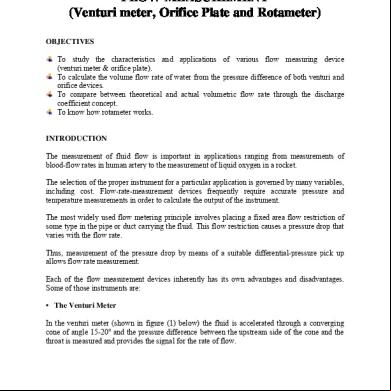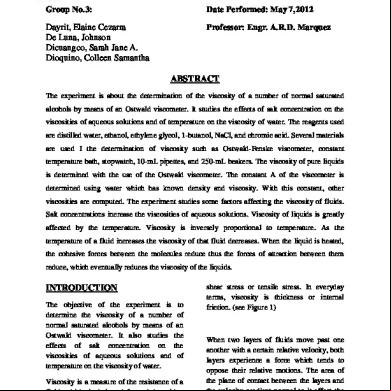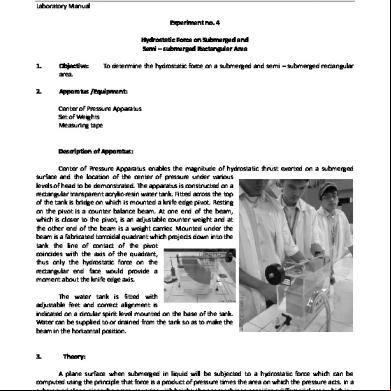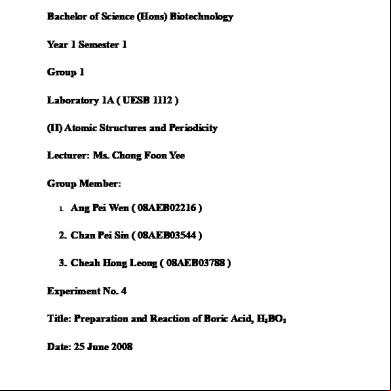Experiment No 4 Flow Measurements 1f4d2b
This document was ed by and they confirmed that they have the permission to share it. If you are author or own the copyright of this book, please report to us by using this report form. Report 2z6p3t
Overview 5o1f4z
& View Experiment No 4 Flow Measurements as PDF for free.
More details 6z3438
- Words: 1,523
- Pages: 7
FLOW MEASUREMENT (Venturi meter, Orifice Plate and Rotameter) OBJECTIVES To study the characteristics and applications of various flow measuring device (venturi meter & orifice plate). To calculate the volume flow rate of water from the pressure difference of both venturi and orifice devices. To compare between theoretical and actual volumetric flow rate through the discharge coefficient concept. To know how rotameter works.
INTRODUCTION The measurement of fluid flow is important in applications ranging from measurements of blood-flow rates in human artery to the measurement of liquid oxygen in a rocket. The selection of the proper instrument for a particular application is governed by many variables, including cost. Flow-rate-measurement devices frequently require accurate pressure and temperature measurements in order to calculate the output of the instrument. The most widely used flow metering principle involves placing a fixed area flow restriction of some type in the pipe or duct carrying the fluid. This flow restriction causes a pressure drop that varies with the flow rate. Thus, measurement of the pressure drop by means of a suitable differential-pressure pick up allows flow rate measurement. Each of the flow measurement devices inherently has its own advantages and disadvantages. Some of those instruments are: • The Venturi Meter In the venturi meter (shown in figure (1) below) the fluid is accelerated through a converging cone of angle 15-20° and the pressure difference between the upstream side of the cone and the throat is measured and provides the signal for the rate of flow.
Upstream pressure tap
Downstream pressure tap
Venturi Throat
Upstream Flow
Downstream Flow Figure (1) : The Venturi meter operation.
The fluid slows down in a cone with smaller angle (5-7°) where most of the kinetic energy is converted back to pressure energy. Because of the cone and the gradual reduction in the area there is no "vena contracta". The flow area is at minimum at the throat. High pressure and energy recovery makes the venturi meter suitable where only small pressure heads are available. A discharge coefficient Cv- of 0.975 may be taken as standard, but the value varies noticeably at low values of the Reynolds' number. : : : : : : :
The pressure recovery is much better for the venturi meter than for the orifice plate. The venturi tube is suitable for clean, dirty and viscous liquid and some slurry services. Pressure loss is low. Typical accuracy percent is ±i of full range. Required upstream pipe length 5 to 20 diameters. Viscosity effect is high Relative cost is medium
•
The Orifice Plate
The orifice meter shown in figure (2) below, consists of a flat orifice plate with a circular hole drilled in it. There is a pressure tap upstream from the orifice plate and another just downstream. There are in general three methods of placing the taps. The coefficient of the meter depends upon the position`n of taps. ™ Flange location - Tap location 1 inch upstream and 1 inch downstream from face of orifice. ™ Vena contracta location - Tap location 1 pipe diameter (actual inside) upstream and 0.3 to 0.8 pipe diameter downstream from face of orifice. ™ Pipe location - Tap location 2.5 times nominal pipe diameter upstream and 8 times nominal pipe diameter downstream from face of orifice.
Orifice Plate
Downstream Flow Upstream Flow
Inlet Pipe Pressure Manometer
Figure (2) : The Orifice Plate operation. The discharge coefficient - Co - varies considerably with changes in area ratio and the Reynolds' number. A discharge coefficient - Co - of 0.60 may be taken as standard, but the value varies noticeably at low values of the Reynolds number. The pressure recovery is limited for an orifice plate and the permanent pressure loss depends primarily on the area ratio. For an area ratio of 0.5, the head loss is about 70 -75% of the orifice differential. ♦ ♦ ♦ ♦ ♦ ♦
The orifice meter is recommended for clean and dirty liquids and some slurry services. The pressure loss is medium Typical accuracy is ±2 to ±4 of full scale The required upstream diameter is 10 to 30 The viscosity effect is high. The relative cost is low.
Application of Energy Principle to Tube-Type Flow meters The energy equation can be used to derive the venturi meter (shown in figure (3) below) equation by assuming general case not horizontal and due to its short length, there is no head loss, hf = 0. Although these assumptions were made to simplify the derivation, the final results will be identical for any orientation of the venturi meter.
Figure (3): The Venturi meter. Thus: P V2 P V2 1 + z1 + 1 = 2 + z2 + 2 γ 2g γ 2g
By the continuity equation for the approach and throat sections: V1 Al = V2 A2 Either VI or V2 can be solved for in of the other; for example: VI =V2 (A2/A1) Substituting this result into the energy equation results in: P −P V2 − V2 1 2 + (z1 - z2) = 2 1 γ 2g Solving for V2:
V2 = 2 g
⎡ P1 − P2 ⎤ + (z1 - z2)⎥ ⎢ ⎢⎣ γ ⎥⎦ ⎛A 1 − ⎜⎜ 2 ⎝ A1
⎞ ⎟⎟ ⎠
2
Taking the square root of both sides and multiplying both sides by A2 results in the theoretical discharge equation:
.
Q Th = A2 2 g
⎡ P1 − P2 ⎤ + (z1 - z2)⎥ ⎢ ⎢⎣ γ ⎥⎦ ⎛A 1 − ⎜⎜ 2 ⎝ A1
⎞ ⎟⎟ ⎠
2
To obtain actual discharge, a coefficient, Cd, added to compensate for velocity distribution and for minor losses not ed for in the energy equation yields: ⎡ P1 − P2 ⎤ + (z1 - z2 )⎥ ⎢ . ⎢⎣ γ ⎥⎦ Q Th = C A 2 g d 2 2 ⎛A ⎞ 1− ⎜ 2 ⎟ ⎜A ⎟ ⎝ 1⎠
APPARATUS Figure (4) below, shows the apparatus, it equipment consists of :
Water Outlet Rotameter
H Orifice plate A Water Inlet
A
Venturimeter
B
D
E
F
G
C
Figure (4): Explanatory Diagram of the Flow Measuring Apparatus 1. A Perspex venture meter; a long gradually converging section followed by a throat then by a long diverging section. 2. Orifice plate meter; this meter made from a brass plate with a hole of reduced diameter through which the fluid flows, is mounted between two pressure tapped Perspex flanges (E) and (F). 3. Right angled bend, in which we can derive bend loss coefficient from pressure tapped (G) and (H). 4. Rotameter; this consists of a transparent tapered tube in which a float takes up an equilibrium position. 5. Control valve in which water returns to the hydraulic bend and weight tank.
o Pressure measurement are made at venture entry (A), venture throat (B),venture exit (C),orifice entry (D), tapped Perspex flanges (E) & (F), right-angled pressure tapped (G) & (H),and rotameter pressure drop (II) & (I). o Calibration characteristics for the rotameter in figure (5).
Figure (5) : Rotameter calibration curve. The flow measuring apparatus is connected to the hydraulic bench water supply and the control valve is adjusted until the rotameter is about at mid-position in its calibrated tapered tube. Air is removed from the manometer tubing by flexing it. The pressure within the manometer reservoir is now varied and the flow rate decreased until, with no flow, the manometer height in all tubes is about 280 mm. The apparatus is now ready to operate: 1- Switch on the main power supply of the bench. 2- Open water inlet valve. 3- Put 2.5 kg mass on the weight hanger and notice the hanger movement (measure time required to fill water in the tank) and record it in table (3). 4- Record the pressure head at points A, B, C, D, E, F, G, H, and I in table (2). 5- Notice the rotameter reading. 6- Change valve setting and repeat above steps. REQUIREMENTS 1. 2. 3. 4. 5.
Calculate the discharge coefficient for both the venture and orifice plate for each flow rate. Calculate Reynolds number for each flow rate. Fill table (4) of the values you get in 2&3. Plot the discharge coefficient against Re for both the venture tube and the orifice plate. Check the accuracy of the rotameter.
6. How does the rotameter operate? 7. Show the difference between venture and orifice by filling table (l). 8. Comment on your results. Table (1) : Comparison between flow measurement devices Venturi meter
Orifice plate
Accuracy Pressure Loss Pressure recovery Cost Space Table (2) : Data observed for flow measurement devices
A
B
C
Manometer Level (mm H2O) D E F
G
H
I
venture entry (A), venture throat (B),venture exit (C),orifice entry (D), tapped Perspex flanges (E) & (F), right-angled pressure tapped (G) & (H), and rotameter pressure drop (II) & (I) Table (3) : Observed Data for Rotameter and mass collected Float Height (cm)
Volume flow rate (m3/s)
Mass flow rate (kg/s)
Mass of water collected (kg)
Table (4) : Final results. Reynolds' Number Discharge Coefficient for Venturi (Cv)
Time needed (sec)
Discharge Coefficient for Orifice (Co)
INTRODUCTION The measurement of fluid flow is important in applications ranging from measurements of blood-flow rates in human artery to the measurement of liquid oxygen in a rocket. The selection of the proper instrument for a particular application is governed by many variables, including cost. Flow-rate-measurement devices frequently require accurate pressure and temperature measurements in order to calculate the output of the instrument. The most widely used flow metering principle involves placing a fixed area flow restriction of some type in the pipe or duct carrying the fluid. This flow restriction causes a pressure drop that varies with the flow rate. Thus, measurement of the pressure drop by means of a suitable differential-pressure pick up allows flow rate measurement. Each of the flow measurement devices inherently has its own advantages and disadvantages. Some of those instruments are: • The Venturi Meter In the venturi meter (shown in figure (1) below) the fluid is accelerated through a converging cone of angle 15-20° and the pressure difference between the upstream side of the cone and the throat is measured and provides the signal for the rate of flow.
Upstream pressure tap
Downstream pressure tap
Venturi Throat
Upstream Flow
Downstream Flow Figure (1) : The Venturi meter operation.
The fluid slows down in a cone with smaller angle (5-7°) where most of the kinetic energy is converted back to pressure energy. Because of the cone and the gradual reduction in the area there is no "vena contracta". The flow area is at minimum at the throat. High pressure and energy recovery makes the venturi meter suitable where only small pressure heads are available. A discharge coefficient Cv- of 0.975 may be taken as standard, but the value varies noticeably at low values of the Reynolds' number. : : : : : : :
The pressure recovery is much better for the venturi meter than for the orifice plate. The venturi tube is suitable for clean, dirty and viscous liquid and some slurry services. Pressure loss is low. Typical accuracy percent is ±i of full range. Required upstream pipe length 5 to 20 diameters. Viscosity effect is high Relative cost is medium
•
The Orifice Plate
The orifice meter shown in figure (2) below, consists of a flat orifice plate with a circular hole drilled in it. There is a pressure tap upstream from the orifice plate and another just downstream. There are in general three methods of placing the taps. The coefficient of the meter depends upon the position`n of taps. ™ Flange location - Tap location 1 inch upstream and 1 inch downstream from face of orifice. ™ Vena contracta location - Tap location 1 pipe diameter (actual inside) upstream and 0.3 to 0.8 pipe diameter downstream from face of orifice. ™ Pipe location - Tap location 2.5 times nominal pipe diameter upstream and 8 times nominal pipe diameter downstream from face of orifice.
Orifice Plate
Downstream Flow Upstream Flow
Inlet Pipe Pressure Manometer
Figure (2) : The Orifice Plate operation. The discharge coefficient - Co - varies considerably with changes in area ratio and the Reynolds' number. A discharge coefficient - Co - of 0.60 may be taken as standard, but the value varies noticeably at low values of the Reynolds number. The pressure recovery is limited for an orifice plate and the permanent pressure loss depends primarily on the area ratio. For an area ratio of 0.5, the head loss is about 70 -75% of the orifice differential. ♦ ♦ ♦ ♦ ♦ ♦
The orifice meter is recommended for clean and dirty liquids and some slurry services. The pressure loss is medium Typical accuracy is ±2 to ±4 of full scale The required upstream diameter is 10 to 30 The viscosity effect is high. The relative cost is low.
Application of Energy Principle to Tube-Type Flow meters The energy equation can be used to derive the venturi meter (shown in figure (3) below) equation by assuming general case not horizontal and due to its short length, there is no head loss, hf = 0. Although these assumptions were made to simplify the derivation, the final results will be identical for any orientation of the venturi meter.
Figure (3): The Venturi meter. Thus: P V2 P V2 1 + z1 + 1 = 2 + z2 + 2 γ 2g γ 2g
By the continuity equation for the approach and throat sections: V1 Al = V2 A2 Either VI or V2 can be solved for in of the other; for example: VI =V2 (A2/A1) Substituting this result into the energy equation results in: P −P V2 − V2 1 2 + (z1 - z2) = 2 1 γ 2g Solving for V2:
V2 = 2 g
⎡ P1 − P2 ⎤ + (z1 - z2)⎥ ⎢ ⎢⎣ γ ⎥⎦ ⎛A 1 − ⎜⎜ 2 ⎝ A1
⎞ ⎟⎟ ⎠
2
Taking the square root of both sides and multiplying both sides by A2 results in the theoretical discharge equation:
.
Q Th = A2 2 g
⎡ P1 − P2 ⎤ + (z1 - z2)⎥ ⎢ ⎢⎣ γ ⎥⎦ ⎛A 1 − ⎜⎜ 2 ⎝ A1
⎞ ⎟⎟ ⎠
2
To obtain actual discharge, a coefficient, Cd, added to compensate for velocity distribution and for minor losses not ed for in the energy equation yields: ⎡ P1 − P2 ⎤ + (z1 - z2 )⎥ ⎢ . ⎢⎣ γ ⎥⎦ Q Th = C A 2 g d 2 2 ⎛A ⎞ 1− ⎜ 2 ⎟ ⎜A ⎟ ⎝ 1⎠
APPARATUS Figure (4) below, shows the apparatus, it equipment consists of :
Water Outlet Rotameter
H Orifice plate A Water Inlet
A
Venturimeter
B
D
E
F
G
C
Figure (4): Explanatory Diagram of the Flow Measuring Apparatus 1. A Perspex venture meter; a long gradually converging section followed by a throat then by a long diverging section. 2. Orifice plate meter; this meter made from a brass plate with a hole of reduced diameter through which the fluid flows, is mounted between two pressure tapped Perspex flanges (E) and (F). 3. Right angled bend, in which we can derive bend loss coefficient from pressure tapped (G) and (H). 4. Rotameter; this consists of a transparent tapered tube in which a float takes up an equilibrium position. 5. Control valve in which water returns to the hydraulic bend and weight tank.
o Pressure measurement are made at venture entry (A), venture throat (B),venture exit (C),orifice entry (D), tapped Perspex flanges (E) & (F), right-angled pressure tapped (G) & (H),and rotameter pressure drop (II) & (I). o Calibration characteristics for the rotameter in figure (5).
Figure (5) : Rotameter calibration curve. The flow measuring apparatus is connected to the hydraulic bench water supply and the control valve is adjusted until the rotameter is about at mid-position in its calibrated tapered tube. Air is removed from the manometer tubing by flexing it. The pressure within the manometer reservoir is now varied and the flow rate decreased until, with no flow, the manometer height in all tubes is about 280 mm. The apparatus is now ready to operate: 1- Switch on the main power supply of the bench. 2- Open water inlet valve. 3- Put 2.5 kg mass on the weight hanger and notice the hanger movement (measure time required to fill water in the tank) and record it in table (3). 4- Record the pressure head at points A, B, C, D, E, F, G, H, and I in table (2). 5- Notice the rotameter reading. 6- Change valve setting and repeat above steps. REQUIREMENTS 1. 2. 3. 4. 5.
Calculate the discharge coefficient for both the venture and orifice plate for each flow rate. Calculate Reynolds number for each flow rate. Fill table (4) of the values you get in 2&3. Plot the discharge coefficient against Re for both the venture tube and the orifice plate. Check the accuracy of the rotameter.
6. How does the rotameter operate? 7. Show the difference between venture and orifice by filling table (l). 8. Comment on your results. Table (1) : Comparison between flow measurement devices Venturi meter
Orifice plate
Accuracy Pressure Loss Pressure recovery Cost Space Table (2) : Data observed for flow measurement devices
A
B
C
Manometer Level (mm H2O) D E F
G
H
I
venture entry (A), venture throat (B),venture exit (C),orifice entry (D), tapped Perspex flanges (E) & (F), right-angled pressure tapped (G) & (H), and rotameter pressure drop (II) & (I) Table (3) : Observed Data for Rotameter and mass collected Float Height (cm)
Volume flow rate (m3/s)
Mass flow rate (kg/s)
Mass of water collected (kg)
Table (4) : Final results. Reynolds' Number Discharge Coefficient for Venturi (Cv)
Time needed (sec)
Discharge Coefficient for Orifice (Co)










